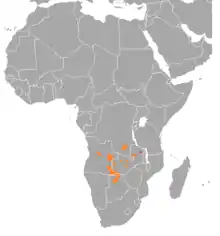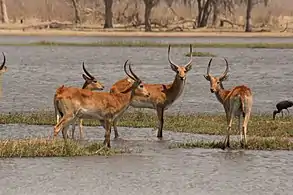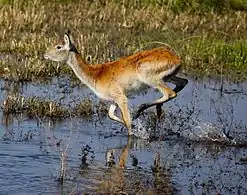Lechwe
The lechwe (Kobus leche), red lechwe or southern lechwe, is an antelope found in wetlands of south central Africa.
| Lechwe | |
|---|---|
_male.jpg.webp) | |
| male K. l. leche Nkasa Rupara National Park, Namibia | |
| Scientific classification | |
| Kingdom: | Animalia |
| Phylum: | Chordata |
| Class: | Mammalia |
| Order: | Artiodactyla |
| Family: | Bovidae |
| Genus: | Kobus |
| Species: | K. leche |
| Binomial name | |
| Kobus leche Gray, 1850 | |
| Subspecies | |
 | |
| Distribution range of lechwe | |
Range
It is native to Botswana, Zambia, southeastern Democratic Republic of the Congo, northeastern Namibia, and eastern Angola, especially in the Okavango Delta, Kafue Flats and the Bangweulu Swamps. It has been recorded in Kakadu National Park along the highway in Northern Territory, Australia.[2]
Description
Lechwe stand 90 to 100 cm (35 to 39 in) at the shoulder and weigh from 70 to 120 kg (150 to 260 lb). They are golden brown with white bellies. Males are darker in colour, but general hue varies depending on subspecies. The long, spiral-structured horns are vaguely lyre-shaped, they are found only in males. The hind legs are somewhat longer in proportion than in other antelopes, to ease long-distance running in marshy soil.
 Adults in the Okavango Delta
Adults in the Okavango Delta Female running
Female running_juvenile.jpg.webp)
_males_fighting%252C_composite.jpg.webp)
Habitats
Lechwe are found in marshy areas where they eat aquatic plants. They use the knee-deep water as protection from predators. Their legs are covered in a water-repellant substance which allows them to run quite fast in knee-deep water. Lechwe are diurnal. They gather in herds which can include many thousands of individuals.[3] Herds are usually all of one sex, but during mating season they mix.[4]
Taxonomy
Subspecies
Four subspecies of the lechwe have been recognized.[5][6]
- Red lechwe (Kobus leche leche) (Gray, 1850) - Widely distributed in the wetlands of Zimbabwe, Botswana, Namibia and Zambia.
- Kafue Flats lechwe (Kobus leche kafuensis) (Haltenorth, 1963) - It is confined within the Kafue Flats (seasonally inundated flood-plain on the Kafue River, Zambia).
- † Roberts' lechwe (Kobus leche robertsi) (Rothschild, 1907) - Formerly found in northeastern Zambia, now extinct. Also called the Kawambwa lechwe.
- Black lechwe (Kobus leche smithemani) (Lydekker, 1900) - Found in the Bangweulu region of Zambia.
In addition the Upemba lechwe (Kobus anselli) is also considered a subspecies by some authorities (as Kobus leche anselli).[7]
Although related and sharing the name "lechwe", the Nile lechwe (K. megaceros) is consistently recognized as a separate species.[6]
Reproduction
Lechwe mates during rain seasons of November to February. They have a gestation period of seven to eight months so a majority of calves are born from July to September. [8]
See also
- Cape lechwe, Kobus venterae
- Nile lechwe, Kobus megaceros
References
- IUCN SSC Antelope Specialist Group (2017). "Kobus leche". IUCN Red List of Threatened Species. 2017: e.T11033A50189021. doi:10.2305/IUCN.UK.2017-2.RLTS.T11033A50189021.en. Retrieved 12 January 2018. Database entry includes a brief justification of why this species is of Near Threatened.
- https://www.abc.net.au/local/stories/2013/08/14/3825580.htm Antelope In Kakadu
- Windhoek, UrbanCamp net | Camping | Leisure |. "Lechwe". urbancamp.net. Retrieved 2020-05-30.
- Nefdt, Rory J. C.; Thirgood, Simon J. (1997). "Lekking, resource defense, and harassment in two subspecies of lechwe antelope". Behavioral Ecology. 8: 1–9. doi:10.1093/beheco/8.1.1.
- Wilson, D.E.; Reeder, D.M., eds. (2005). Mammal Species of the World: A Taxonomic and Geographic Reference (3rd ed.). Johns Hopkins University Press. p. 720. ISBN 978-0-8018-8221-0. OCLC 62265494.
- Groves, C.; Grubb, P. (2011). Ungulate Taxonomy. Baltimore: Johns Hopkins University Press. pp. 190–1. ISBN 978-1-4214-0093-8.
- IUCN SSC Antelope Specialist Group (2008). "Kobus leche anselli". IUCN Red List of Threatened Species. 2008. Retrieved 23 November 2016.CS1 maint: ref=harv (link)
- Newell, T. 1999. "Kobus leche" (On-line), Animal Diversity Web. Accessed March 06, 2020 at https://animaldiversity.org/accounts/Kobus_leche/
External links
| Wikimedia Commons has media related to Kobus leche. |

